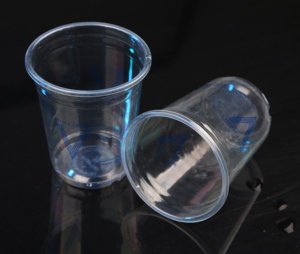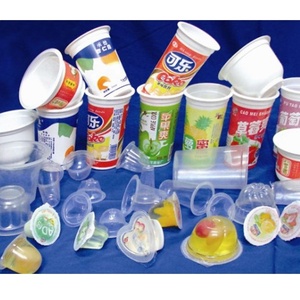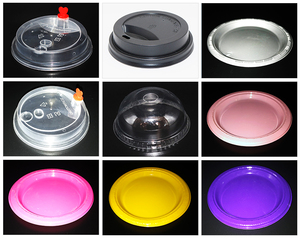
All categories
Featured selections
Trade Assurance
Buyer Central
Help Center
Get the app
Become a supplier

(1894 products available)



















Industrial companies can use the following types of cup thermoforming molds for different applications.
Blow molds
The cup is created by blowing air into a heated plastic cup. The process begins by placing a plastic preform into a thermoforming oven. The preform is then transferred into the blow mold. Compressed air is then blasted into the preform, expanding it until it fits the mold's interior walls. The cup is cooled and solidified by applying cooling water to the mold.
Deep draw molds
Deep draw molds have a single or multi-cavity design. The thermoforming process using deep draw molds typically involves a three-step procedure. First of all, heated plastic sheets are draped over the mold or pulled down onto the mold. Next, the sheet is stretched over or into the mold. Finally, the formed cup is trimmed from the sheet.
The depth of the mold cavity determines the shape and size of the thermoformed cup. Deep draw molds are made of heat-resistant materials that can withstand high temperatures.
Drill Rims
Drilled rim molds are used to create cups with complex or specialized rims, such as precision holes for specific applications. They usually consist of a cavity and a matching plate with holes corresponding to the desired cup rim shape. Then, the drill is used to inject plastic into the cavity, forming a cup with a drilled rim. The cup is further processed as required.
Drilled rim molds have long lead times and are more expensive. Moreover, they may need to be upgraded or changed to accommodate different cup shapes and sizes.
Multi-cavity molds
Multi-cavity cup thermoforming molds are designed to produce multiple cups from a single sheet of material in one thermoforming cycle. The advantage of this type of mold is that it improves production efficiency and reduces material waste. Furthermore, multi-cavity molds are suitable for large-volume production.
Open molds
The open mold design is the most straightforward. It usually consists of two parts: an upper mold and a lower mold. During the thermoforming process, the upper and lower molds are separated to form the thermoformed cup. Open molds have a simple construction, easy operation, and are suitable for small and medium-size production.
Rotary molds
Stress is applied to the sheets in a rotary mold. Rotary molds have two or more identical cavities. A motor drives the rotary molding system to rotate. Heated plastic sheets are moved into the cavities, where the sheets are stretched and formed into cups. After being cooled, the cups take the shape of the cavities and are released.
Rotary molds have high efficiency and are suitable for mass production. Furthermore, they have great stability and precision. Rotary molds are an excellent option for making items with consistent quality and complex designs.
Details regarding the specifications for cup thermoforming molds are as follows:
Maintaining the thermoforming mold is very important if businesses want to ensure its durability and consistent performance. Regular cleaning is necessary to remove any debris or residue from the mold forming process. A mild detergent should be used with warm water, and any dry or residual liquid should be promptly and thoroughly removed.
Frequent inspections of the mold will reveal any signs of damage, wear, or tear. These issues should be addressed as soon as possible to avoid compromising the quality of the products being produced. Any parts of the mold that are difficult to access should be thoroughly cleaned and dried to avoid moisture buildup, which can lead to mold or corrosion.
If there are any minor scratches or imperfections, these should be carefully polished out. Proper lubrication of moving components of the mold will help prevent premature wear and tear and ensure smooth operation. The thermoforming cup mold should be stored in a dry and clean place away from direct sunlight or extreme temperature changes. This will prevent distortion.
Cup thermoforming molds are used in various industries, and their applications are still growing.
Packaging industry
Cup thermoforming molds create diverse packaging products, such as clamshells, trays, blisters, and containers. These packaging products are typically produced using cup thermoforming plastic molds like PVC, PET, and PS. The packaging items are commonly used for food, consumer goods, electronics, and medical products. The packaging industry prefers using cup thermoforming molds because they are efficient and can cater to lots of packaging needs.
Food and beverage industry
In the food and beverage industry, cup thermoforming molds are used to make cups for desserts, ice cream, yogurt, and beverages. The industry chooses to use cup thermoforming molds because they can produce cups of different shapes and sizes.
Medical and pharmaceutical manufacturing
Medical and pharmaceutical manufacturing may use cup thermoforming molds to produce medical cups, containers, and trays. These are used for sample holders, dosage cups, and diagnostic test trays. Using cup thermoforming molds guarantees precise and hygienic products that fulfill the strict industry standards and regulations.
Cosmetics and personal care
Cosmetics and personal care product suppliers can use cup thermoforming molds to produce cosmetic containers, jars, and packaging for beauty products. The molds are popular in this industry because they allow for custom designs to suit different brands.
Industrial packaging
A few industrial products, such as automotive parts, electronic components, and machinery, also come in packaging made using a cup thermoforming mold. Industrial packaging requires sturdy and reliable packaging. Cup thermoforming molds meet this need. They can produce durable packaging for heavy-duty use.
The following tips can help business buyers to choose suitable thermoforming cups for their industrial needs:
Assess production capacity
Determine the production capacity by considering factors like the available equipment, number of employees, and supply chain constraints. Analyze the existing manufacturing processes to identify any necessary adjustments or investments to accommodate cup thermoforming. Assess the ability to implement and maintain efficient production lines, quality control systems, and training programs for the workforce.
Adaptability
Purchasers should pick thermoforming cup molds that are flexible enough to accommodate a variety of materials, including plastics, paper, and foam. Additionally, they ought to be able to produce a variety of cup designs and sizes, from straightforward single-wall cups to sophisticated insulated and multi-layer cups with various closing mechanisms.
Maintainability
The ability to clean, repair, and replace essential components of the molds quickly is referred to as maintainability. Purchasing companies should prioritize molds that are simple to handle and have comprehensive repair manuals. Quick service and replacement parts should be provided by the suppliers to reduce downtime and enhance production effectiveness.
Quality of materials used
Quality, longevity, and performance of molded cups are all influenced by the materials employed in cup thermoforming molds. To provide effective thermal and impact resistance, buying organizations must use high-grade steel alloys, such as aluminum, brass, or template steel. To guarantee the molds' long-term viability and stable production outcomes, they should cooperate with suppliers who use dependable and durable materials.
Budget
The initial outlay for buying the molds and the long-term operational costs related to maintenance, energy consumption, and material usage are all influenced by budgeting considerations. Select molds that strike a fair balance between performance and cost while staying within the budget constraints. To reduce extra costs and enhance return on investment, consider the long-term energy efficiency and production effectiveness of the selected molds.
Q1: What Technologies Used in Cup Thermoforming?
A1: There are different technologies used in cup thermoforming. Specifically, the flow latch thermoforming technology is widely used in the industry. This technology is known for its efficiency in producing various complex shapes. It offers significant cost benefits to manufacturers.
Q2: What are the trends in cup thermoforming?
A2: The cup thermoforming industry is moving towards more sustainable materials and energy-efficient processes. Developments like automated thermoforming machines and digital mold design are reshaping the landscape.
Q3: Is Cup Thermoforming Automation Possible?
A3: Yes, automation is a significant trend in cup thermoforming. Automated systems improve production speed, consistency, and efficiency.
Q4: Are Custom Designs Possible in Cup Thermoforming Molds?
A4: Yes, one of the advantages of cup thermoforming is the possibility of custom designs. Anonymous manufacturers can create unique shapes and sizes according to specific requirements.